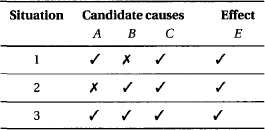CHAPTER 14
MILL’S METHODS
In science and everyday life, we think a lot about causes and effects. Knowledge about causation allows us to understand the world, make predictions, and change things. In this chapter and the next one we shall discuss some of the principles of causal reasoning. First we start with a set of rules known as “Mill’s methods.” They were formulated by the famous English philosopher John Stuart Mill (1806–1873), who wrote on a wide range of topics from logic and language to political philosophy. When we have an observed effect E, we can use Mill’s methods to find its cause by following this procedure:
1. Identify a set of candidate causes—events or conditions that happened before E, and one of them is suspected to be the cause of E.
2. Collect information about a range of situations involving these candidate causes, and determine whether E occurred afterward in these situations.
3. Based on the information collected, use one of the five rules below to infer the cause of E.
Let us now look at the five rules one by one and see how they are applied.
14.1 THE METHOD OF AGREEMENT
If two or more situations leading to an effect E has only one event C in common, then C is the cause of E.

The method of agreement is the rule stated above, and the table illustrates how the rule can be applied. We want to find the cause of E, which was present in three situations corresponding ...

